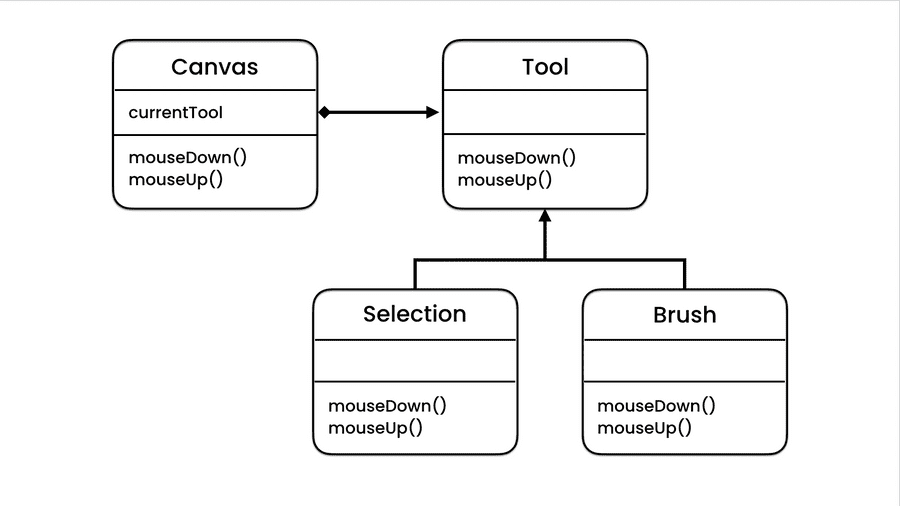📏
Implement State Pattern
When we use state pattern?
when we want to implement some features in our software like Brush or Selection in Photoshop, we use this pattern and this pattern make our project extendable.
UML of this pattern:

Tool interface:
Java
public interface Tool {void mouseDown();void mouseUp();}
BrushTool class:
Java
public class BrushTool implements Tool {@Overridepublic void mouseDown() {System.out.println("Brush icon");}@Overridepublic void mouseUp() {System.out.println("Draw a line");}}
SelectionTool class:
Java
public class SelectionTool implements Tool {@Overridepublic void mouseDown() {System.out.println("Selection icon");}@Overridepublic void mouseUp() {System.out.println("Draw a dash rectangle");}}
Canvas class
Java
public class Canvas {private Tool currentTool;public void mouseDown(){currentTool.mouseDown();}public void mouseUp(){currentTool.mouseUp();}public Tool getCurrentTool() {return currentTool;}public void setCurrentTool(Tool currentTool) {this.currentTool = currentTool;}}
Main class
Java
var canvas = new Canvas();canvas.setCurrentTool(new BrushTool());canvas.mouseDown();canvas.mouseUp();
Open Closed Principle
This principle says we can extend our features and software and add new classes but we should not change our previous classes.
Python State design pattern
Tool class:
Python
class Tool:def mouse_down(self):passdef mouse_up(self):pass
BrushTool class:
Python
from state.Tool import Toolclass BrushTool(Tool):def mouse_down(self):print("Brush icon")def mouse_up(self):print("Draw a line")
SelectionTool class:
Python
from state.Tool import Toolclass SelectionTool(Tool):def mouse_down(self):print("Selection icon ")def mouse_up(self):print("Draw a dash rectangle")
Canvas class:
Python
class Canvas:def __init__(self):self.__current_tool = Nonedef mouse_down(self):self.__current_tool.mouse_down()def mouse_up(self):self.__current_tool.mouse_up()@propertydef current_tool(self):return self.__current_tool@current_tool.setterdef current_tool(self, current_tool):self.__current_tool = current_tool
Main class:
Python
from state.Brushtool import BrushToolfrom state.Canvas import Canvasfrom state.Selection_tool import SelectionTooldef main():canvas = Canvas()canvas.current_tool = SelectionTool()canvas.mouse_down()canvas.mouse_up()canvas.current_tool = BrushTool()canvas.mouse_up()canvas.mouse_down()
